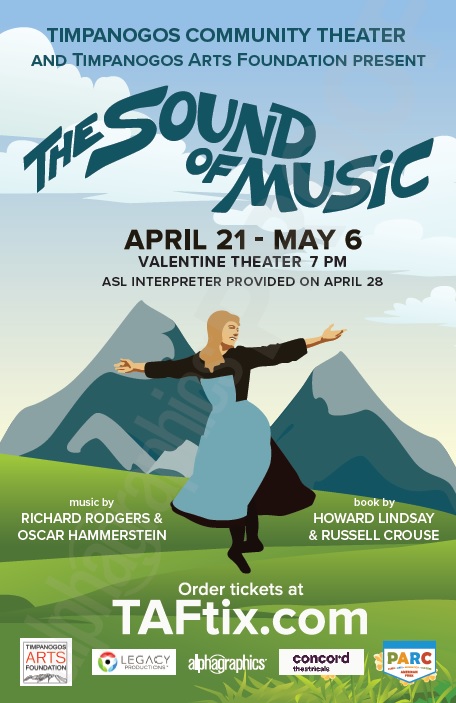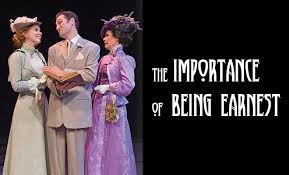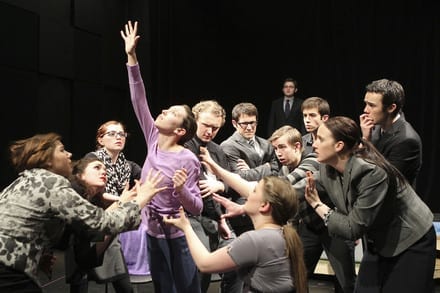AMERICAN FORK — Tucked in the back of a series of old buildings next to the Mount Timpanogos Temple is the Valentine Theater that houses Timpanogos Community Theatre. The spacious theatre was packed with patrons eager to hear again the tale of the Von Trapp Family’s memorable songs of Richard Rodgers and Oscar Hammerstein and the resistance to Nazi invasion in The Sound of Music.

Show closes May 6, 2023.
Maren Miller plays the show’s protagonist Maria, a misfit acolyte in an Austrian abbey whose love of music disturbs the other nuns. Miller’s grasp of the character, her affability with children, and emotional exuberance were exceeded only by her phenomenal voice. It would not have been a surprise for the surrounding mountains to have sung back to Miller’s booming and pitch-perfect refrains of the hills being alive “with the sound of music.” Producing a musical with a character made famous by Julie Andrews is a tall task for any creative team, but casting Miller as Maria was one of many wins that elevated this production incredibly well.
Howard Lindsay and Russel Crouse‘s script for the stage version differs significantly from the beloved film. In his director’s note, Andrew Jeffries addressed the challenge of honoring what is known and appreciated about the film while creating, “a production that is fresh and exciting.” I was impressed at the subtle ways in which Jeffries accomplished his goal. During the play’s climactic scene when the Von Trapp family is compelled to perform in an event celebrating the Anschluss of Austria and Germany, Jeffries had blocked the actors playing Nazi enlisted men to begin patrolling the aisles of the auditorium. It added an element of tension to an already high stakes situation and brought to a live audience moments that can only be accomplished in live theatre.
Similarly, the choreography by Meg Flinders was clean and crisp and aligned with the discipline of Captain Von Trapp’s household and the nuns’ sanctuary. While it is a simple thing, it felt like there was no wasted movement in any of the dance routines of the nuns or the Von Trapp children. The choreography of “So Long, Farewell” hailed to the well-known routine of the film while allowing the Von Trapp children to infuse more of their personality into the choreography. (And Gretl, played by Story Harper, was endearing as the final child to depart.)
Amalie Strongin performed admirably in the role of Liesl. Her initial resistance to Maria was clear in her body language as Maria taught the children to sing “Do-Re-Mi,” even as Liesl began to warm through the song. Perhaps Strongin’s strongest moment was the genuine surprise on her face to hear Maria praying for her as she snuck back into the Von Trapp house after singing “Sixteen Going on Seventeen.” Strongin seemed genuinely conflicted about what or how much to share until the words spilled out of her. The performance underscored the rapport that Miller’s Maria had with each of the children.
One of the show’s strengths was Nicole Madsen’s costuming. So much of The Sound of Music lives in the dress of its characters: nuns in habits, Nazis with swastika armbands, and even the uniformity of the Von Trapp children are integral parts to the story. Each costume was neat, clear, and delivered on the expected visuals for The Sound of Music.
The lighting design of Caleb Wannengren paired well with the scenic design by Nicole and Kurt Madsen. One of the key features of the production was a large backdrop featuring the Untersberg Mountain with a sky that could be lit to change colors for time of day and context. It was a profoundly beautiful effect, as the audience faces Mount Timpanogos in the same direction when exiting the theater. The set pieces of the abbey and Von Trapp estate meshed well next to the ever-present hills that serve as both the home of Maria as well as the family’s ultimate escape route in the story. The set was beautiful and the lighting did an excellent complimentary contributing to the story.
Ultimately, the Timpanogos Community Theater production of The Sound of Music made me think, feel, and engage with the production. While the show is longer than modern musicals, the characters and themes felt present and engaging throughout. Doing work of this caliber within a community theatre context and in a show featuring so many young actors is a tribute to a strong leadership team and a director who found the timelessness and timeliness of the production. Jeffries’s wrote “I hope this performance will transport you to the hills of Austria and inspire you to take a closer look at your own values.” For this reviewer, the production did exactly that.





